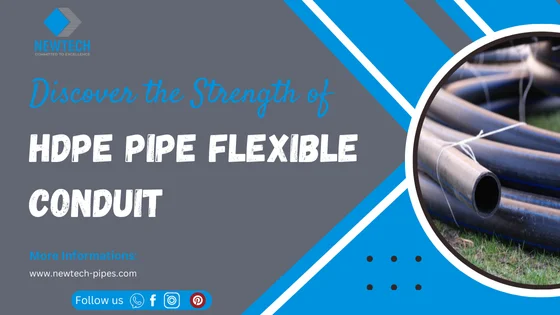Introduction of Strength of HDPE Pipe Flexible Conduit
In the realm of infrastructure development, the choice of materials significantly influences the longevity, efficiency, and resilience of systems. One of the most remarkable innovations in recent years has been the introduction of High-Density Polyethylene (HDPE) Pipe Flexible Conduit. As industries evolve, the demand for superior materials that can withstand diverse environmental challenges continues to rise. This article delves deep into the strength and benefits of HDPE pipe flexible conduit, illustrating why it stands out among traditional materials.
The Evolution of Conduit Materials
Historically, conduits have been constructed from materials like steel and PVC. While effective in their time, these materials have limitations regarding flexibility, durability, and environmental impact. The advent of HDPE marks a significant departure from these conventional choices. This polymer was engineered to overcome the drawbacks of earlier materials, providing an innovative solution that meets modern demands. As industries transition to more sustainable practices, HDPE has emerged as a frontrunner, paving the way for smarter construction techniques.
Understanding HDPE: What Makes It Unique?
High-Density Polyethylene is a thermoplastic made from petroleum. Its unique molecular structure confers impressive physical properties, including high tensile strength, excellent impact resistance, and remarkable flexibility. Unlike traditional materials that may crack or deform under pressure, HDPE maintains its integrity in a wide range of conditions. Its lightweight nature simplifies transport and installation, making it a favorite among engineers and contractors alike.
The Advantages of HDPE Pipe Flexible Conduit
HDPE pipe flexible conduit brings numerous advantages to the table, making it an exceptional choice for various applications.
Unmatched Durability and Strength
One of the most striking attributes of HDPE is its durability. Designed to withstand extreme environmental conditions, HDPE conduit resists wear and tear that would compromise lesser materials. This longevity translates to fewer replacements and repairs, ultimately leading to cost savings.
Resistance to Impact and Fracture
HDPE’s ability to resist impact and fracture is unparalleled. Whether exposed to heavy machinery in industrial settings or natural elements in residential areas, HDPE pipe flexible conduit can endure significant stress without succumbing to damage. This characteristic is vital in ensuring the integrity of electrical and communication lines housed within.
Flexibility: A Game Changer for Installation
The flexibility of HDPE is one of its standout features, providing significant advantages during installation.
Easy Bending and Conforming to Spaces
Unlike rigid conduits, HDPE can bend and twist, conforming to various installation requirements. This flexibility enables it to navigate tight corners and challenging layouts with ease, reducing the need for numerous fittings and joints.
Simplifying Complex Installations
Complex installations often present logistical challenges. However, HDPE’s adaptability simplifies these processes, allowing for quicker and more efficient setups. This not only saves time but also minimizes labor costs associated with intricate installations.
Chemical Resistance and Environmental Benefits
HDPE’s chemical resistance is a testament to its versatility.
How HDPE Stands Up to Harsh Chemicals
In environments where conduits may be exposed to corrosive substances, HDPE shines. Its robust structure resists chemical attack, ensuring that the conduit remains functional over time. This property is especially critical in industrial applications where exposure to hazardous materials is commonplace.
Eco-Friendly Properties of HDPE
In today’s eco-conscious world, the sustainability of materials is paramount. HDPE is not only recyclable but also produced from less harmful manufacturing processes compared to traditional materials. By choosing HDPE, industries can contribute to a reduced carbon footprint, aligning with global sustainability goals.
Comparing HDPE with Traditional Conduit Materials
When considering conduit materials, a comparison between HDPE, PVC, and steel reveals critical insights.
PVC vs. HDPE: The Ultimate Showdown
PVC is a common alternative to HDPE, but it lacks the flexibility and impact resistance that HDPE offers. While PVC is more affordable initially, its susceptibility to brittleness under temperature variations makes HDPE the superior long-term choice.
Steel Conduit: Pros and Cons
Steel is renowned for its strength; however, it is heavy, prone to rust, and expensive to install. In contrast, HDPE provides similar strength without the added weight or maintenance issues, proving to be the more efficient option.
Cost-Effectiveness of HDPE Pipe Flexible Conduit
A thorough examination of costs reveals HDPE’s financial advantages.
Initial Investment vs. Long-Term Savings
While HDPE pipe flexible conduit may have a higher upfront cost than some materials, its longevity and durability translate to substantial long-term savings. Reduced replacement frequency and lower maintenance costs position HDPE as a wise investment.
Reduced Maintenance Costs and Longevity
Thanks to its resistance to corrosion and damage, HDPE requires minimal maintenance. This reliability not only extends the lifespan of the conduit but also decreases the costs associated with upkeep and repairs.
Installation Techniques for HDPE Pipe Flexible Conduit
To maximize the benefits of HDPE, proper installation techniques are essential.
Best Practices for Successful Installation
Employing best practices during installation ensures optimal performance. This includes adhering to manufacturer specifications, utilizing proper fittings, and following recommended bending radii.
Tools and Equipment Needed
Installation of HDPE pipe flexible conduit typically requires specialized tools such as fusion machines for creating seamless joints. Ensuring that crews are equipped with the right tools can significantly enhance installation efficiency.
Real-World Applications of HDPE Pipe Flexible Conduit
The versatility of HDPE is evident across various sectors.
Industrial Uses: From Manufacturing to Mining
In industrial settings, HDPE pipe flexible conduit is invaluable. It protects electrical lines, data cables, and piping systems from the rigors of the working environment, ensuring uninterrupted operations.
Residential Applications: Strength and Safety
For residential uses, HDPE offers a safe and reliable option for protecting utility lines. Its durability ensures that homes remain safe and connected, providing peace of mind for homeowners.
Case Studies: Success Stories with HDPE
Real-world examples illustrate the practical benefits of HDPE.
Innovative Projects Utilizing HDPE Pipe Flexible Conduit
Projects across various sectors showcase HDPE’s strength. From urban development to remote installations, the results speak volumes about its efficacy.
Lessons Learned from Implementing HDPE Solutions
Through case studies, invaluable insights emerge. The lessons learned help to refine installation practices, ensuring future projects benefit from the collective knowledge gained.
Future Trends in Conduit Systems
As technology advances, so does the potential of HDPE.
Technological Advances in HDPE Manufacturing
Innovations in manufacturing techniques are paving the way for even stronger and more flexible HDPE products. These advancements promise to enhance performance and expand application possibilities.
The Growing Importance of Sustainable Infrastructure
With sustainability at the forefront, HDPE’s role in creating eco-friendly infrastructure is becoming increasingly critical. Industries are gravitating toward materials that support environmental responsibility, making HDPE a vital component of future developments.
Common Misconceptions about HDPE Pipe
Addressing misunderstandings is essential for informed decision-making.
Debunking Myths Surrounding HDPE
Misconceptions about HDPE’s performance and applicability often arise. By clarifying these points, stakeholders can make better choices that align with industry standards.
Understanding the Science Behind HDPE Performance
The scientific principles that underpin HDPE’s functionality are fascinating. By delving into the chemistry and engineering aspects, one can appreciate the material’s capabilities.
Conclusion
As industries face the challenges of modern infrastructure needs, HDPE pipe flexible conduit stands out as a robust solution. Its combination of strength, flexibility, and sustainability makes it a smart choice for any project. Embracing HDPE not only ensures the safety and reliability of installations but also supports a more sustainable future for infrastructure development. Making the smart choice today means investing in resilience and efficiency for tomorrow.
FAQs About HDPE Pipe Flexible Conduit
What is HDPE pipe flexible conduit?
HDPE (High-Density Polyethylene) pipe flexible conduit is a type of protective tubing designed to house electrical cables and other utilities. Its flexibility and durability make it ideal for various applications, ranging from industrial settings to residential installations.
What are the main advantages of using HDPE pipe flexible conduit?
The primary advantages include unmatched durability, impact resistance, chemical resistance, flexibility for easy installation, and long-term cost savings due to reduced maintenance and replacement needs.
How does HDPE compare to traditional conduit materials like PVC and steel?
HDPE outperforms PVC and steel in several ways. It is more flexible than PVC, allowing for easier installation in complex layouts. Compared to steel, HDPE is lighter, corrosion-resistant, and less expensive to maintain over time.
Is HDPE pipe flexible conduit eco-friendly?
Yes, HDPE is considered eco-friendly. It is recyclable and produced using processes that have a lower environmental impact compared to traditional materials. Using HDPE contributes to sustainable construction practices.
Can HDPE pipe flexible conduit be used in harsh environments?
Absolutely. HDPE is engineered to withstand harsh chemicals and extreme temperatures, making it suitable for use in industrial settings, mining operations, and other demanding environments.
What installation techniques should be used for HDPE pipe flexible conduit?
Successful installation involves following manufacturer specifications, utilizing the right tools (like fusion machines for joining), and adhering to recommended bending radii to maintain structural integrity.
What are some real-world applications of HDPE pipe flexible conduit?
HDPE pipe flexible conduit is used in various sectors, including manufacturing, telecommunications, residential utilities, and mining. It effectively protects electrical lines and utility systems in these environments.
How does the cost of HDPE compare to other materials in the long run?
While the initial investment in HDPE may be higher than some materials, its durability and low maintenance requirements lead to significant long-term savings, making it a cost-effective choice over time.
Are there any common misconceptions about HDPE pipe flexible conduit?
Yes, some misconceptions include beliefs that HDPE lacks strength or is not suitable for high-pressure applications. In reality, HDPE is engineered for strength and versatility, making it a reliable choice for various applications.
What are future trends regarding HDPE pipe flexible conduit?
Future trends include advancements in manufacturing technologies, increased focus on sustainable infrastructure, and the development of innovative applications for HDPE in emerging industries.


